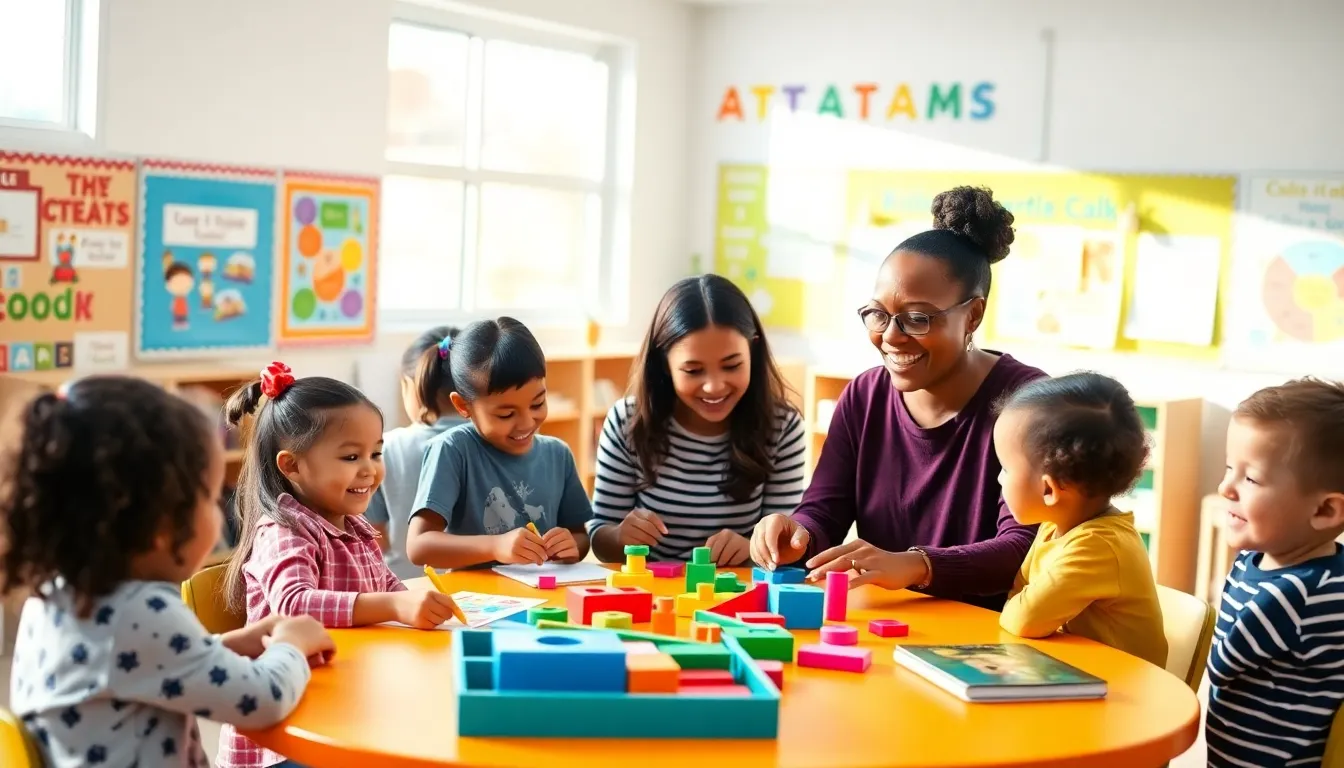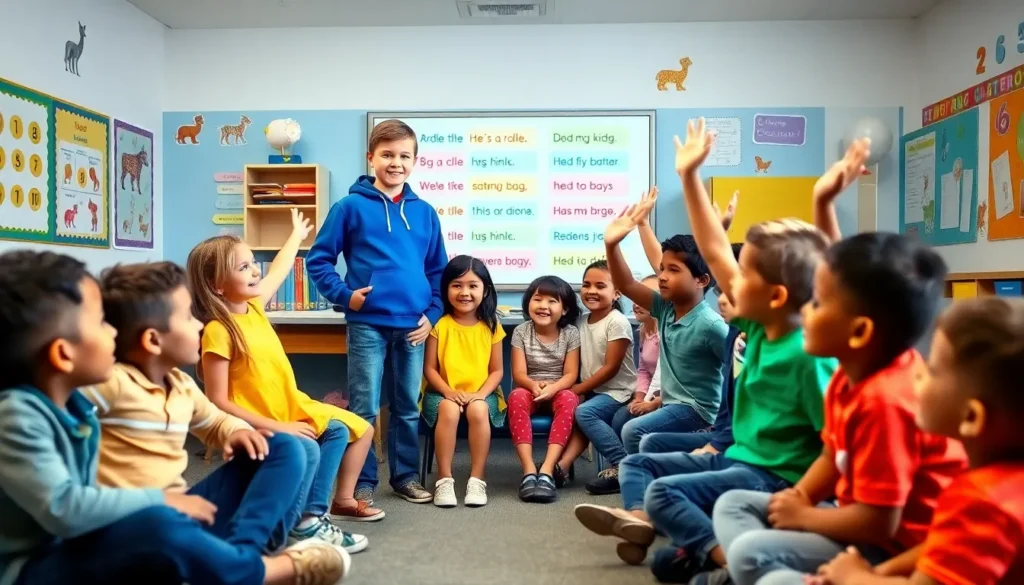When it comes to the big leap into elementary school, parents are often left scratching their heads, or worse, battling a chorus of little voices asking, “Why can’t I go to school yet?” Luckily, understanding when kids start elementary school isn’t rocket science, although you’d think it was based on the sheer confusion out there. From age requirements to state regulations, various factors dictate that magical entry into the world of crayons, nap times, and lunchboxes. Let’s break it down so you can feel confident, and maybe even a bit amused, while navigating this rite of passage.
Table of Contents
ToggleUnderstanding Kindergarten Age Requirements

Kindergarten serves as the first official step in the educational journey. Typically, kids start around the age of five. But, age requirements can vary depending on local regulations and school district policies. For instance, some states require children to turn five by a specific date, like September 1st, to enroll that year. Others let kids in if they turn five after that date, as long as they meet certain criteria like demonstrating readiness. It’s a bit like playing a game of educational checkers: every state has its own rules.
Also, parents should talk to their local schools. Understanding the specific requirements within your school district can help you prepare for that first day of school, which can be as exciting as it is terrifying.
Determining readiness also plays a significant role in this discussion. Just because your child is five doesn’t mean they are ready for the structured setting of kindergarten. Observational cues from preschool programs, playgroups, or bustling daycare centers can provide insight. Is your child eager for learning? Do they display basic social skills? Parents should take note: these signs often indicate they might be ready for the adventure ahead.
Typical Enrollment Age Across States
As previously mentioned, the age at which children can start elementary school varies considerably across states. For example, California requires children to be five by September 1, while places like New York allow enrollment for kids who turn five by December 31. This discrepancy makes it crucial for parents to keep a close eye on state-specific regulations.
In many parts of the Midwest, children often enroll as early as four years and nine months, especially when local programs prioritize early education. Conversely, regions with fewer preschool programs may lean more toward strict enforcement of age requirements, resulting in a larger number of children starting school closer to six.
This patchwork of age policies can lead to questions about fairness and developmental readiness. Parents may wonder: rationalize those extra few months: is it really that critical? Understanding when kids start school can also ease the transition phase and allow room for individual growth.
Also, the trend has been shifting towards earlier enrollment in some areas. With educational research highlighting early learning benefits, many districts are beginning to offer transitional kindergarten or pre-kindergarten programs to support kids needing additional preparation.
Factors Influencing School Start Age
Several factors influence not only the age at which kids start school but also their overall readiness. First, socio-economic status often plays a role. Children from families with greater access to learning resources, such as books, educational toys, and cultural experiences, tend to demonstrate advanced verbal and social skills, allowing them to thrive in a school environment.
Next, parental involvement is another key player. Research shows that when parents engage in their children’s learning, adding books to bedtime stories, visiting museums, or even just discussing daily experiences, those kids often feel more confident and exhibit the readiness traits schools look for.
Finally, the importance of community programs cannot be overstated. Quality pre-kindergarten options with certified instructors can substantially prepare children for the school ride ahead. This may also clarify many parents’ logistical challenges, such as balancing a job and childcare needs during the transition.
Benefits of Starting Early vs. Delaying Enrollment
The debate about whether to enroll a child early or delay their entrance to school is as age-old as the question itself. For those considering an early start, benefits abound. Kids who enter kindergarten sooner often experience socialization opportunities not found in home settings. They develop essential academic skills alongside their peers, from numbers to storytelling, setting the stage for life.
But, it’s not all sunshine and rainbows. The pressure to keep pace may overwhelm some youngsters. While some kids thrive and flourish, others may struggle to adapt to structured classroom environments. So, parents must evaluate their child’s unique traits.
On the flip side, delaying enrollment allows children to develop emotional maturity and interpersonal skills at their own pace. For kids who may face challenges in social interactions, waiting another year can truly make a difference, leading to improved confidence and smoother transitions. The decision often boils down to understanding a child’s individual strengths.
Variations in Curriculum and Readiness
Across the United States, elementary school curricula can significantly differ. In some states, structured play integrates seamlessly with learning math and language, encouraging creativity while reinforcing core subjects. Others may emphasize strict academic prerequisites from day one, laying down the educational law with rigid classroom disciplines. This variation can directly impact readiness, as students who receive a balanced education may find entry into kindergarten smoother.
Plus to curriculum differences, evaluating a child’s readiness goes beyond merely assessing their ability to read or count. Comprehensive assessments often consider emotional, social, and physical development alongside traditional academic benchmarks. Schools and educators are increasingly aware that a happy, engaged child is often a successful one.
How Parents Can Prepare Their Children for School
Preparing children for the adventure of school requires more than just stuffing their backpacks full of crayons and juice boxes. Here’s a checklist parents can follow to ensure their little ones are ready to take on the world:
- Foster a love of learning: Share stories, visit libraries, and encourage curiosity about the world around them. Whether your child is asking “why is the sky blue?” or “how do planes fly?” nurture that interest.
- Create a daily routine: Schools operate on schedules, so teaching your child about time management can ease the transition. Start with consistent wake-up, meal, and playtimes.
- Encourage social interactions: Playdates, outings, or community events help develop social skills. Watching children negotiate, share, or collaborate builds confidence and teamwork.
- Visit the school before classes begin: Familiarity often breeds comfort. Touring the school and meeting the teacher can dispel fears of the unknown.
- Talk openly about school: Share your experiences, answer questions, and make school sound exciting. Normalize feelings of anxiety and reassure your child that it’s perfectly normal to feel nervous.





